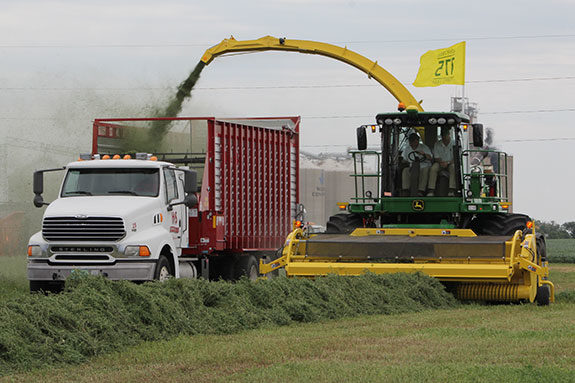Faced with dwindling forage supplies in silos and questionable alfalfa stands, dairy and livestock producers are looking for ideas about growing an early silage crop. Several alternatives are available for growers looking to stretch forage supplies until after corn silage harvest. When exploring your options, there are several key things to know and factors to think about.
What type of forage are you short on?
Consider whether an early to mid-summer forage crop is needed to make up for a shortage of corn silage or haylage.
If making up for haylage and there is already a hay crop growing on the farm, the shortage may be addressed using summer production to supplement a lack of haylage.
In addition, consider planting additional alfalfa acres this spring to increase total farm alfalfa production and avoid running out again in 2014.
Early forage does not deliver starch
If corn silage is running low, then it will be difficult to replace the starch component with an early season forage crop.
Small-grain crops harvested at soft dough will produce a moderate amount of starch, but they will not offer a one-to-one replacement for corn silage in the ration.
Alternatively, starch (in the form of grain) can be added to rations to supplement lower-starch-content forage crops like cool-season grasses.
Small-grain feed type differs based on harvest maturity
Spring-seeded small grains, such as oats, barley or wheat, can be cut at two different growth stages for two different types of feed.
Cut at the boot stage, these forages are very digestible but essentially have no starch. Cut at the soft-dough stage, they provide starch and higher dry matter yield but will have a lesser digestible forage fraction.
Either harvest stage can make good forage, but differences exist in harvest timing, yield, nutrient contributions to the ration and feeding dynamics.
Annual grasses can deliver early and season-long yields of moderate-quality forage
Grass crops need to be harvested in a timely manner to maximize quality. Tonnage will be best in spring and fall, when days are cooler and moisture is more abundant.
A grass crop will deliver only moderate fiber digestibility and no high starch. It makes a nice supplement to the dairy ration but will not duplicate the fiber digestibility or protein content of alfalfa.
Salvaging existing alfalfa stands is only a short-term fix
When alfalfa stands are marginal and forage is needed, growers may think about harvesting at least the first cutting from these fields.
Doing so can provide some short-term relief for empty silos, but rarely is it economical for the farm enterprise when compared to rotating the stand to another crop like corn silage.
Research shows that it is best to plow down marginal alfalfa fields and rotate them. If alfalfa and grass make up a significant portion of the mixture, then fertilize heavily with nitrogen to maximize yield.
When making decisions about early forage cropping options, the key nutritional benefits of alfalfa and corn silage will help determine what early spring forage crop to grow.
Alfalfa delivers protein
No crop provides crude protein yield like alfalfa. It’s top of the list for total season protein production.
Corn silage delivers yield and starch
No crop provides total dry matter and starch production like corn silage. It tops the list for total season digestible energy production. FG
PHOTO
Staff photo.
Daniel Wiersma
Livestock Information Manager
DuPont Pioneer











